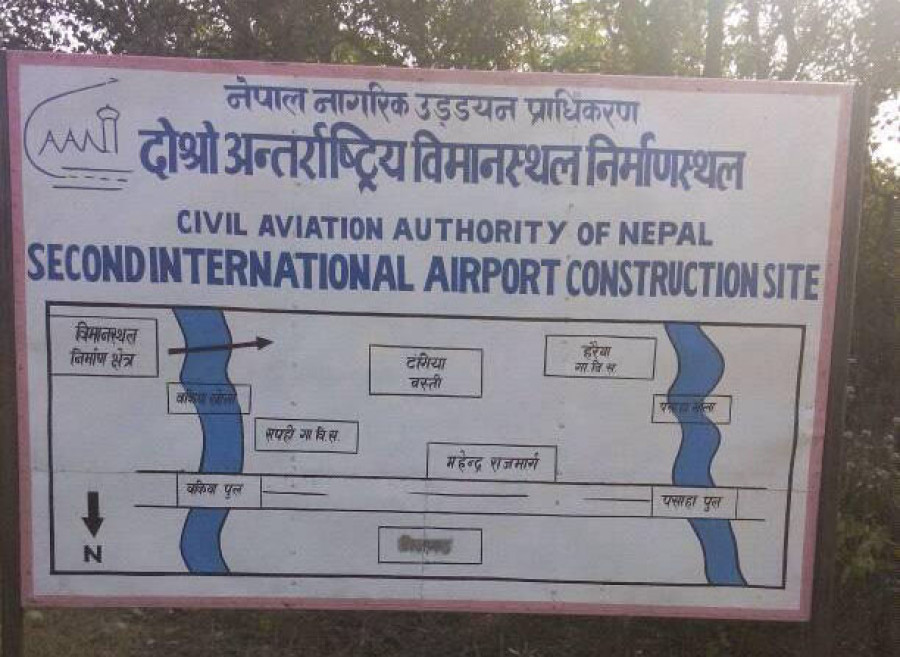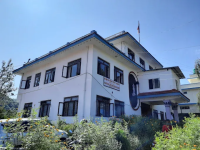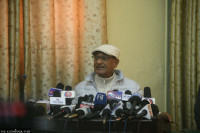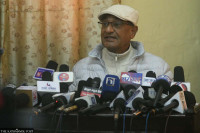National
Amid environmentalists’ concern, tourism minister repeats he will build Nijgadh airport
Debate should focus on location rather than on whether Nepal needs another international airport, environmentalists say.
Chandan Kumar Mandal
Since assuming office, Minister of Culture, Tourism and Civil Aviation Yogesh Bhattarai has made building Nijgadh International Airport in Bara his one-point agenda. Or at least it so appears. Not even a single public appearance of his since becoming the tourism minister on July 31 has gone without the one refrain: “we will build Nijgadh airport at any cost.”
Most of his statements, including the one in which he claimed to bring together hundreds of thousands of people in support of the airport, have been met with fierce criticism.
On Thursday, Bhattarai once again repeated his same refrain on Nijgadh airport, largely ignoring environmentalists’ warnings.
“It’s not that the government is not aware of the environmental damage the project could do,” said Bhattarai at an event organised to release the environmental, social and economic impact of Nijgadh airport. “Although the government has not gone there to haphazardly destroy everything, we know the damages that will happen with the construction of the airport.”
Environmentalists have been raising concerns regarding the airport’s construction since the environmental impact assessment of the multi-billion project was passed last year, calling the project disastrous for the environment, wildlife and people living around the area.
But Bhattarai said the proposed airport is “something that future generations will remember for a long time.”
The planned airport located 175 kilometres south of Kathmandu, will be spread over 80 square kilometres and is set to be the biggest airport in South Asia in terms of areas.
“The government is not unaware of the debates going around. We will not ignore these issues,” said Bhattarai. “We will not move from the present location, which has been approved as the most appropriate site by various studies,” he said right after receiving a report which has raised various concerns about the project for its adverse impacts on the overall ecosystem and wildlife.
The report prepared by the Nepal Forum of Environmental Journalists (NEFEJ) pointed out that the current plan has ignored significant issues related to forest cover, drinking water resources, birds and other wildlife, impact on Chure region, flooding in downstream areas, management of Tangia Basti settlement, environmental pollution, and degradation of existing ecological services.
The report further questioned the motive behind going ahead with the project without the Detailed Project Report (DPR) and also recommended reviewing the current EIA report which has been mired in controversy since it came into the public domain.
According to Bhattarai, the country needs another international airport because the Tribhuvan International Airport, the sole international airport, will reach its maximum utilisation by 2022.
“TIA, which is serving nearly eight million passengers with an annual rise of 7.5 percent, cannot bear the pressure any longer. We need another airport,” said Bhattarai. “For a country like Nepal, which is a landlocked country and relies heavily on its tourism sector, air route is the most feasible route to bring more tourists.”
Prachanda Jung Shah, a former captain, said there were so many misconceptions among the government officials, activists as well as public regarding the Nijgadh airport project.
“Once completed, Nijgadh airport will be the primary international airport for the country. It is not an alternative airport to TIA; it will complement the TIA,” said Shah. “The government should be assertive about the project and its current location.”
Sprawling over 8045.79 hectares, the proposed Nijgadh airport would require clearing a forest area of 2.4 million trees. The planned construction site lies amid dense forests with nearly 90 per cent of the project area covered by Shorea robusta trees, also known as sal or sakhua.
The proposed site is adjacent to the Parsa Wildlife National Park, a corridor for big wildlife like tigers and elephants and a habitat of rich biodiversity. The current project site also passes between two rivers— Lalbakaiya and Pasaha river—and other small creeks.
While the government made its intentions clear that it would move ahead with the current construction plan at any cost, environmentalist and development practitioners continue to raise concerns about the possible damage because of the mega-project.
Prabhu Budhathoki, a former National Planning Commission member and biodiversity expert, said the debate was not about whether we need an international airport or not.
“The whole debate is about its current location which is significant for the ecosystem, environmental services and wildlife,” said Budhathoki.
According to Budhathoki, the government might face trouble in the future for taking the environment for granted while constructing the airport.
“The whole world is taking environmental issues more seriously than ever, but we are moving ahead with this airport,” said Budhathoki. “Funding for the project can be a problem. Also, what if other countries and airlines companies ban us or refuse to come to this airport because of environmental concerns? We can move to other least controversial location, which is available.”
Recently, eight companies from seven countries have expressed interest to construct the airport. As per the Environment and Social Impact Assessment (ESIA) report, nearly 770,000 trees will be chopped down during the first phase of the project.
Environmentalists have also been questioning the validity of the EIA report which has been criticised for being faulty, with some saying parts of it were directly copied from elsewhere.
According to Batu Krishna Upreti, former chief of environment assessment section of the Ministry of Environment, said the current EIA of the project did not meet even the basic standards of the EIA.
“The present EIA document is not about the construction of the airport, but about removing the settlement from Tangiya Basti and cutting down trees. Only the cover page of this report says it is an EIA report,” said Upreti. “The beauty of the EIA is giving an alternative analysis which is missing in this report. It moves ahead bulldozing with one location. If we move ahead with this EIA, then we have plenty of examples of how big projects have failed in the past.”
The government has been defending the current project site saying it was selected among eight other places which were studied for the construction of the airport. However, conservationists are not ready to buy this argument.
Anand Bhattarai, a forest and environment expert, said the feasibility study of the project on other locations was never made public.
“Chitwan was not selected because of its proximity with Chitwan National Park. Likewise, Butwal was also not chosen because of three rivers around,” said Bhattarai. “Then why the current location, which is adjacent to Parsa National Park and also two rivers, was selected.”
Due to project area’s proximity to rivers like Lalbakaiya and Pasaha and other small rivulets, environmentalists have been warning that the construction of airport could spell flooding in nearby areas like Gaur, Gadhimai, Kalaiya and Birgunj.
Bhattarai said the project would move ahead ensuring maximum benefit and minimum damages.
“The government will not work haphazardly, causing environmental damage. We will simultaneously introduce environmental management plan,” said Bhattarai. “The government will respond to international concerns on why the project site was chosen. In a few months, we will finalise all the modalities of the project.”
***
What do you think?
Dear reader, we’d like to hear from you. We regularly publish letters to the editor on contemporary issues or direct responses to something the Post has recently published. Please send your letters to [email protected] with "Letter to the Editor" in the subject line. Please include your name, location, and a contact address so one of our editors can reach out to you.




 16.12°C Kathmandu
16.12°C Kathmandu













%20(1).jpg&w=300&height=200)

